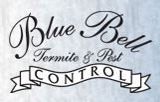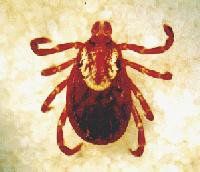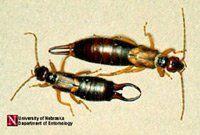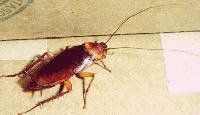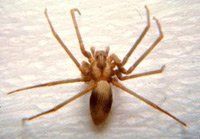FAQ
- Q: Why should I hire a pest management professional?
A: Professional pest managers are specialist that are educated, trained, and certified to handle pest management issues. Qualified pest management professionals have the necessary experience and tools to provide protection against irritating and destructive pest. Modern pest managers practice integrated pest management (IPM) where they first identify and monitor the offending pest and then design an effective program to control, manage or eliminate the pest from your home while protecting the safety of you, your family and your pets.
- Q: How can I be sure that the pesticides being used in either over- the-counter products or by professionals are safe for my home and family?
A: Pesticides (which include disinfectants and other household cleaners as well) are intended to be safe to consumers and the pest professionals that use them. Before being approved by the U.S Environmental Protection Agency (EPA) for a specified use against a target pest, pesticides must undergo stringent controlled test and studies. After approval, pesticides are subjects to strict laws, regulations and controls to ensure that they are used correctly and according to approved labels. In addition, pest management professionals are required to attend pesticides safety and applicator certification at least every two years in most states. All legally registered pesticides that are approved by EPA have a registration number on their label which also contains detailed instructions hen a ensure that when a pesticide is used according to these instructions it will not harm you, before using an over-the-counter pesticide, read the entire label and follow all instructions.
- Q: I recently opened up my pantry door and found moths flying around the food? Are these insects dangerous and what can I do to get rid of them?
A: There are several moths that are considered pantry pest. The moths are not dangerous but are a nuisance especially when they breed and their larvae infest various foods such as cereal, flour, and gains. Larvae will feed on food in protected areas and then move away from food to pupate or rest until emerging in their adult forms as moths. The best way to eliminate an infection is to thoroughly clean the infected area. Seal infested food in plastic bags and discard it in the trash. Seal similar food items in clear plastic bags as well, especially if they had been stored near any infested products for very long. Vacuum all cracks where grains might be spilled. A pest management professional can accurately identify the type of moth in your pantry and prescribe a treatment that is tailored to meet your specific needs.
- Q: How can I keep wasps from nesting near my home? I am worried about my children's safety?
A: In early spring, most social wasps come out of hibernation and look for ideal places to start there nest. They will be less likely to nest on your property if you make it less attractive to them. Make sure that garbage placed outside is kept clean, tightly sealed containers. If you have fruit trees in your yard, consider removing them or regularly removing fruits that have fallen and began to rot on the ground. Keep screens tightly secured on windows and doors and make sure that they do not have gaps or openings in them. It is a good idea to hire a pest management firm to remove any old nest and check for wasp activity. They can monitor and prevent wasps from successfully constructing new nests on your home. A pest manager will also be able to advise you on other changes that may be needed to reduce wasp activity on your property.
- Q: What's the best way to get rid of mice now without using pesticides or poisons and how can I keep them out?
A: Snap traps can be used with or without bait to capture mice. Place the traps in areas where you have seen mice, their droppings are near any suspect holes. Glue-type traps may also be used if you are comfortable using them. Look for small holes and openings near the ground, around the roof, and behind bushes an on the outside of your home. Also, examine where wires, drains, and other utilities come into and out of your home. If you notice any openings, try to seal them up. Mice are very clever and can gnaw though a variety of tough materials. You may have to add fixtures like door sweeps, metal screens, or other sealants to keep them out. Inside, look for evidence of droppings, gnawing, and other chewing damage.
- Q: What's the difference between ants and termites?
A: Ants typically have elbowed antennae and the midsections of their bodies have “pinched waists.” Termites have antennae that are not elbowed and the middles of their bodies are thicker and not thin and narrow. If wings are present, the front and back wings of ants will vary in shape and size, while the front and back wings in termites are very similar in shape and size.
- Q: How can I tell if I have a termite infestation and what are the signs of damage associated with termites?
A: Termites feed on cellulose in wood and paper products such as books, cardboard, and various other items. Termite damage in homes is usually not obvious until significant damage has occurred. Sometimes homeowners first notice termites when they swarm. Swarmers are winged reproductive that leave the colony in a swarm to mate, reproduce, and form a new colony. Yet, it's the worker termites, that are seldom seen, that are the most numerous and the cause of most of the termite damage. Subterranean termites, the most common type, build nests in the ground and often construct mud tubes on structures. They use the mud tubes as passageways to explore for food and travel to and from the soil. If you suspect that you have a termite infestation, you should have your home thoroughly inspected by a termite specialist.
- Q: How long does a typical subterranean termite treatment, applied by a professional pest management company, maintain its effectiveness?
A: There are many factors that can affect the longevity of the various termite treatments applied today including the type of treatment performed, environmental conditions, type and pH of the soil, or physical disruption of the treatment site. Ideally, treatments can last several years.
- Q: The termite company wants us to sign a contract to continue termite treatments. How long does it take to get rid of termites? And what sort of warranty (if any) is usually given after a termite treatment is preformed?
A: Depending on the situation it can take a few hours to several years to control a termite problem. The construction of your home, the area and extent of infection, the species of termite infesting your home as well as the treatment method you select, are some of the factors that have an affect on how quickly termites can be eliminated from your home. If more than one colony exists in any given area, or if you live in an area where well- established colonies exist, it can take more time to gain adequate control. There is no typical warranty in the pest management industry for termite treatments. Warranties tend to vary site to site and can depend on the extent of your home's termite infection and the type of treatment preformed. Whatever treatment or maintenance contract that you choose, make sure that you get any warranties and other guarantees in writing and stay updated on any termite problems and activity on your property. Also be sure to ask for a complete explanation of the terms of warranty and read all documents carefully before you sign them.
Seasonal Pests/Problems
What To Do If You Experience a Swarm
- Close off the room in which the insects are swarming.
- Collect a few to show your inspector.
- Use a vacuum cleaner to remove insects after they have swarmed.
- If possible, note the exact locations from which the swarmers are emerging.
Facts About The Termite Swarming Process
- A "swarm" is a dispersal flight of winged termites to start new colonies.
- Subterranean termites typically swarm in the spring on warm, calm, sunny days following rain.
- Subterranean termite swarms usually occur between mid-morning and mid-afternoon and may last several hours.
- Drywood termites and Formosan termites swarm during the evening around or just after dusk.
- Termites swarming indoors will attempt to get outside by flying toward light around windows and doors or even toward lights that are on in the room.
- Swarmers shed their wings after flight, as they will never fly again.
- After shedding their wings, the termites mate, then seek out sites to begin new colonies.
- Wood in contact with moist soil is a suitable colony site for subterranean termites.
- Interior swarms of subterranean termites will not reinfest the structure or its contents.
- A recent termite treatment may not prevent swarming, as the swarmers may have already moved above the treatment zone in the soil when the application was performed.
Winged Ant Swarming Facts
- Like termite colonies, mature ant colonies produce winged reproductives called swarmers that fly out to start new colonies.
- Most ant species swarm in mid- to late spring or summer.
- An ant colony will typically be at least two to three years old before it produces swarmers.
- Fire ants may swarm six or seven times over the course of the spring and summer.
- Pavement ants produce small swarms that may emerge daily or every few days over a period of several weeks.
Carpenter Ants
Successfully controlling carpenter ants requires certain skills, knowledge and experience. Carpenter ant control involves tracking down and treating as many satellite colonies as possible inside and outside of the home as well as attempting to find and treat the parent colony. Accessing the parent colony may be difficult because it might be located high in a tree or on a neighboring property. In such cases, your service professional may use carpenter ant baits, but these may have varying results because of the carpenter ants' finicky feeding habits. If conditions on your property (such as a large number of trees) create a high risk for reinfestation, your service professional may recommend regular pest management services to help prevent new infestations. These tips will help you limit carpenter ant infestation:
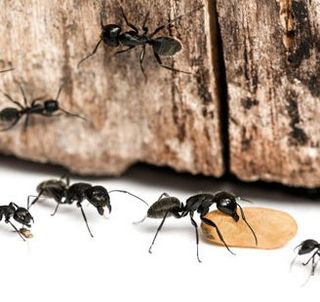
- Store any firewood away from your home and remove any dead wood or wood scraps from around the foundation.
- Trim dead limbs from trees and remove stumps. Rid your yard of these potential nesting sites.
- Make sure that all plumbing or roof leaks are sealed, and check crawl spaces for excess moisture.
- Water from rain gutters should be directed away from your home and not be allowed to accumulate close to the foundation.
Pavement Ant
Individual pavement colonies can often be controlled using ant baits, but perimeter inspection and treatment are commonly necessary for long-term relief. Pavement ant colonies are controlled by direct treatment of nests in the soil. Where colonies are located under slabs, ant baits may be successful in controlling an infestation. If baits are unsuccessful, the slab may need to be drilled and treated underneath. These tips will help prevent a pavement ant infestation:
- Seal cracks and holes in the exterior of the home to prevent ants and other pests from entering.
- Keep vegetation cut away from the foundation of the home.
- Avoid using items such as stones and landscape timbers next to the home's foundation. Pavement ants nesting under these items are likely to infest the home.
- Keep layers of mulch in landscape beds less than two inches thick and at least 12 inches away from the foundation.
House Mouse
The best way to avoid invasions of mice is to (1) provide as little harborage as possible that might attract rodents, and (2) seal as many holes and cracks in the outside of the home through which mice might enter. Follow these recommendations to help prevent rodents from seeking the shelter provided by your home:
- Keep firewood stored as far from the home as possible and store it off the ground. During the winter, store only enough wood next to the house to burn every couple of days.
- If possible, remove any piles of debris, stones, bricks, etc. If these are near the foundation of the home they serve as harborages to attract rodents. Once there, it is any easy step for rodents to enter the building itself.
- Do not allow piles of leaves to accumulate next to the home's foundation. This also serves as attractive harborage for rodents - mice in particular.
- Seal any hole or crack larger than 1/4 of an inch. A good rule of thumb is that if a pencil can fit into it, a mouse could too. Large holes or cracks should be stuffed with steel wool or wire mesh before sealing with caulk or foam, otherwise rodents could chew through to enter.
- Install good, thick weatherstrip on the bottom of all doors to prevent rodents from entering. The garage door may prove difficult to seal completely, so the door from the garage to the house must be sealed tightly.
Other Pests
The images below will help you identify other pests.
We provide a 1-Year
warranty with all WDI Inspections.
Call 215-491-7412
Today to eliminate your pest and termite problems.
